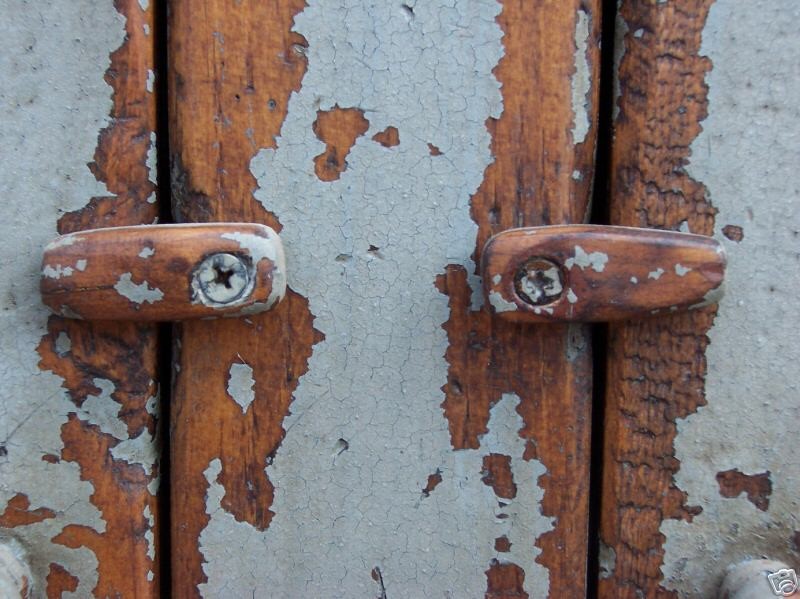Chipped Paint Finish
Tips on achieving the look of chipped, cracked, eroded paint. August 17, 2009
Question
I really like what is going on with this paint. It is chipping off as well as crackling and crazing. I would like to use either pigmented lacquer or maybe milk paint. I assume I would use crackle lacquer for the lacquer, but is there anything I can do to it to modify the sizes of the crackles? Or what else could I use or do? What about the chipping off Ė can I use a sandblaster?

Click here for higher quality, full size image
Forum Responses
(Finishing Forum)
From contributor D:
This method has been posted many times on this forum. Check chipped paint finish in the archive. As far as using "crackle lacquer", thatís probably not the way to go. This finish will most likely use some form of wax to act as a relief agent between the stained wood and the paint.
From contributor D:
Sorry for any confusion. The schedule I would personally use would be as follows:
1. Distress wood to desired effect.
2. Stain wood to desired color.
3. Seal stained wood and finish as if you were leaving it stained.
4. Place butchers wax on areas you would like to see the wood through.
5. Apply opaque finish to piece and allow to dry.
6. Scrape off waxed areas.
Note: the waxed areas will scrape off easily. You can scrape more off to achieve the desired effect.
From contributor P:
How would you achieve the crackle effect in your proposed schedule? I was trying to do a similar finish a month or two ago. I was somewhat successful, but I couldn't quite get the chipped edge effect.
From contributor R:
You wonít get the chipped effect using a wax. The wax is a good idea for other types of "rub" through types of finishes but not this one. To get the irregular chipping that I see in your sample you use a cabinet scraper on a fully cured coating - conversion varnishes work fine. Oil based paints and liquid stripper work even better. For the small cracks you see use the clear based crackle that Campbell makes. The crackle they make is great. Oh - did I say a fully cured? Thatís important so the coating chips off the surface in an irregular manner.
From contributor D:
Wax can be used to achieve this effect. You need to apply the wax in globs (excuse the technical terminology) trying to avoid rubbing the wax thinly. Using a cabinet scraper will remove the blobs and serrate the edges. With distressed finishes the wax will make your life easier.
From the original questioner:
Contributor D, thanks for your continued input. Contributor R, please elaborate on the use of the scraper. I am not seeing how it comes into play.
From contributor R:
With both hands holding the cabinet scraper bend it a bit towards you. Make sure you have a keen edge burnished on the scraper. You want a nice "hook". Find the proper angle and scrape the finish. Push the scraper away from you. Since you have tweaked the scraper a little the center area of it will be doing the work. Practice on the angle and the correct amount of hand pressure. The finish will come off in irregular chips. Have you ever watched an airplane pilot practice touch and go landings? They come in at a low angle, touch the surface, and then take off again. Thatís how you want to approach the scraping. Like I mentioned the angle and pressure is real important. Keep a sharp "hook" on the edge too and donít forget to practice. I think you will like the look.
From the original questioner:
So you were saying to remove the paint with the scraper? I thought you were talking about the crackle.
From contributor R:
For the crackle look into Campbellís crackle base. They make about three kinds so look for the one they make for small cracks. Some companies make a crackle that gives all sizes of cracks depending on how wet you apply it and how thin you thin it. This one is clear so you can add color to it or just use it as a clear and then apply a glaze over it.
The comments below were added after this Forum discussion was archived as a Knowledge Base article (add your comment).
Comment from contributor J:
This finish can be easily replicated using Art Masking Fluid. It's a medium generally used in water color painting. You paint the liquid on the prepared wood and allow it to dry. It dries to a rubbery consistency. Paint the topcoat on top. Apply one-step crackle medium. After all coats are dry, use a white eraser (brick type) and rub over the areas where the masking medium was applied. It leaves a chipped irregular finish just like the one in the picture. Sand lightly and apply aging glaze and a wax or urethane top coat.
